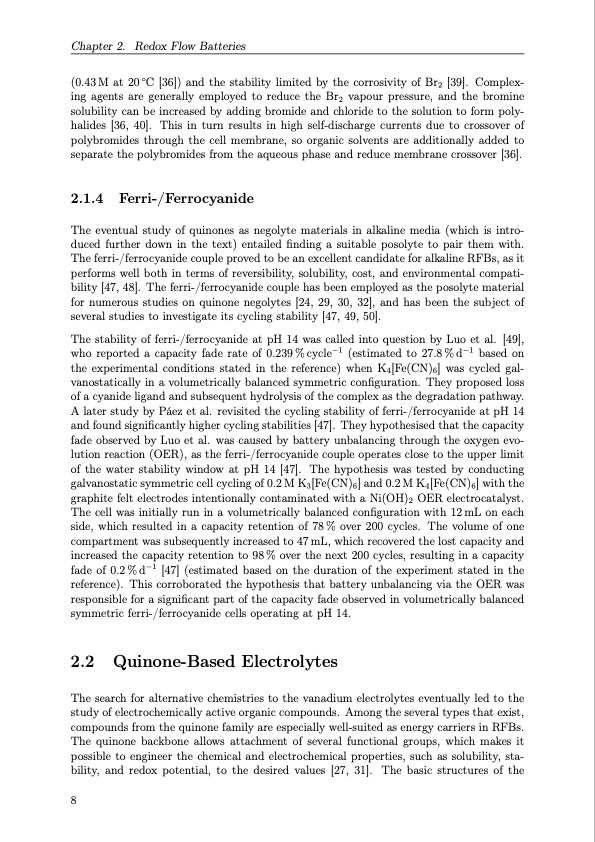
PDF Publication Title:
Text from PDF Page: 029
Chapter 2. Redox Flow Batteries (0.43 M at 20 ◦C [36]) and the stability limited by the corrosivity of Br2 [39]. Complex- ing agents are generally employed to reduce the Br2 vapour pressure, and the bromine solubility can be increased by adding bromide and chloride to the solution to form poly- halides [36, 40]. This in turn results in high self-discharge currents due to crossover of polybromides through the cell membrane, so organic solvents are additionally added to separate the polybromides from the aqueous phase and reduce membrane crossover [36]. 2.1.4 Ferri-/Ferrocyanide The eventual study of quinones as negolyte materials in alkaline media (which is intro- duced further down in the text) entailed finding a suitable posolyte to pair them with. The ferri-/ferrocyanide couple proved to be an excellent candidate for alkaline RFBs, as it performs well both in terms of reversibility, solubility, cost, and environmental compati- bility [47, 48]. The ferri-/ferrocyanide couple has been employed as the posolyte material for numerous studies on quinone negolytes [24, 29, 30, 32], and has been the subject of several studies to investigate its cycling stability [47, 49, 50]. The stability of ferri-/ferrocyanide at pH 14 was called into question by Luo et al. [49], who reported a capacity fade rate of 0.239%cycle−1 (estimated to 27.8%d−1 based on the experimental conditions stated in the reference) when K4[Fe(CN)6] was cycled gal- vanostatically in a volumetrically balanced symmetric configuration. They proposed loss of a cyanide ligand and subsequent hydrolysis of the complex as the degradation pathway. A later study by Páez et al. revisited the cycling stability of ferri-/ferrocyanide at pH 14 and found significantly higher cycling stabilities [47]. They hypothesised that the capacity fade observed by Luo et al. was caused by battery unbalancing through the oxygen evo- lution reaction (OER), as the ferri-/ferrocyanide couple operates close to the upper limit of the water stability window at pH 14 [47]. The hypothesis was tested by conducting galvanostatic symmetric cell cycling of 0.2 M K3[Fe(CN)6] and 0.2 M K4[Fe(CN)6] with the graphite felt electrodes intentionally contaminated with a Ni(OH)2 OER electrocatalyst. The cell was initially run in a volumetrically balanced configuration with 12 mL on each side, which resulted in a capacity retention of 78 % over 200 cycles. The volume of one compartment was subsequently increased to 47 mL, which recovered the lost capacity and increased the capacity retention to 98 % over the next 200 cycles, resulting in a capacity fade of 0.2%d−1 [47] (estimated based on the duration of the experiment stated in the reference). This corroborated the hypothesis that battery unbalancing via the OER was responsible for a significant part of the capacity fade observed in volumetrically balanced symmetric ferri-/ferrocyanide cells operating at pH 14. 2.2 Quinone-Based Electrolytes The search for alternative chemistries to the vanadium electrolytes eventually led to the study of electrochemically active organic compounds. Among the several types that exist, compounds from the quinone family are especially well-suited as energy carriers in RFBs. The quinone backbone allows attachment of several functional groups, which makes it possible to engineer the chemical and electrochemical properties, such as solubility, sta- bility, and redox potential, to the desired values [27, 31]. The basic structures of the 8PDF Image | Organic Redox Flow Batteries 2023

PDF Search Title:
Organic Redox Flow Batteries 2023Original File Name Searched:
PhD_thesis_final_dorhoff_4_.pdfDIY PDF Search: Google It | Yahoo | Bing
Salgenx Redox Flow Battery Technology: Salt water flow battery technology with low cost and great energy density that can be used for power storage and thermal storage. Let us de-risk your production using our license. Our aqueous flow battery is less cost than Tesla Megapack and available faster. Redox flow battery. No membrane needed like with Vanadium, or Bromine. Salgenx flow battery
| CONTACT TEL: 608-238-6001 Email: greg@salgenx.com | RSS | AMP |